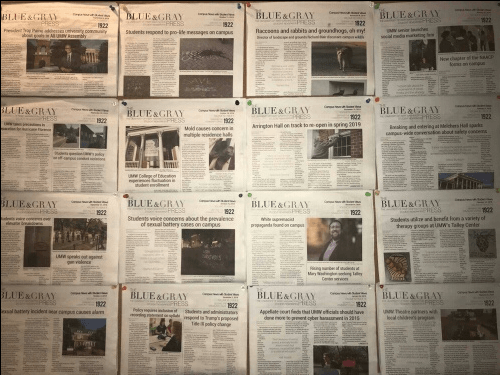The print edition of the paper is inefficient and wasteful compared to online publication benefits, student says
3 min read
Grace Winfield
By SAMUEL WEINSTEIN
Staff Writer
The Blue and Gray is an important part of UMW’s culture and identity. The fact that any student can join the paper and write for it is wonderful and inclusive, and opens the paper up to all different views and ideas. There are 24 locations on campus to pick up the paper, allowing for all those thoughts and ideas to easily be spread throughout the student body. The more places to pick up the paper, however, means more papers need to be printed. While the Blue and Gray is a valuable part of UMW, it isn’t worth printing each week. It would be more efficient to cut the physical paper and only publish articles online.
The most important thing to do when evaluating the worth of something is to look at its cost. In May of 2018 the Student Finance Committee denied the Blue and Gray’s request for $13,665.12 to print the paper for the year, as reported by Jeff Branscome of the Free Lance-Star. If the money being used to print the paper was cut and used for other projects, the committee could fund additional requests, which could have a bigger impact than a physical paper.
Finance Committee member Hannah Goad said, “we’ve had to make a lot of cuts to make sure we can fund stuff like Devil Goat Day and Spring Formal and we wouldn’t be as stressed if we had the money that usually goes towards printing out the Blue and Gray.”
By funding the Blue and Gray, the resources of the Finance Committee are stretched thin, limiting their ability to provide funding for important parts of UMW’s culture.
Another factor to consider when evaluating the worth of the Blue and Gray is the impact it has on the environment. 1000 papers a week printed for 24 weeks a year is 24,000 papers. That is a very significant amount of paper. Taking steps to eliminate the paper now would help to fight pollution and waste. The problem with the physical paper is that regardless of whether or not they get read, they all end up in the garbage or recycling, making the printing of the paper terribly wasteful.
Instead of focusing just on why print copy is bad, it is also necessary to look at why digital copy is good. The Blue and Gray is already available online and is easily accessible. Phones, iPads, and computers can all access the website, and in this age of technology where nearly everyone has a smartphone, there is no need to print hundreds of papers each week when students can already access it right from their pocket.
Other universities have taken steps to either move online or reduce the number of papers they print each week for various reasons. Mt. San Antonio College stopped printing a paper in 2015, opting to use the website Medium to post stories and articles. At first they were only getting readership on bigger stories, while smaller pieces were left mostly ignored. They adapted by creating a Twitter account to report on the smaller things that people may not want to read an article on, but would still want to be informed about. The University of Syracuse stopped its Friday publications in 2008 in an effort to save money. In 2015, those in charge of the paper revamped it, and decided to focus more on digital aspects by hiring a new assistant video editor.
The benefits of having a paper purely online vastly outnumber the benefits of keeping the physical paper financially, environmentally and logistically. The extra money could potentially go back to the student body and support other clubs, rather than using it to pay for a paper that could be just as easily read on a computer.


